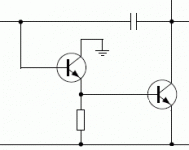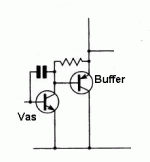And if so what were your impressions?? I have built the example in Doug Selfs blameless and so far have found it to be quite lucid and musical, my current source consists of two transistors and a resistor of 68,1 ohm for a 9-10ma bias..I was using a bootstrapped vas stage prior and found the bass to be too mushy by comparison, and only after comparison.. So far after using mr selfs input differential idea and vas idea with an alteration in the current source i dont understand why he gets so much flack in the diy community, so far his ideas have proven to me to be sonically satisfying in a non fatiguing way, is it his focus on distortion measurements??..
Thanks
Colin
Thanks
Colin
Hi,
I like Self for the technical solutions to achieve examplary technical performance.
I do not like his absolute reliance on low distortion to exclusion of all else. Sound quality is important to most of us and he completely avoids that.
I think the Miller compensation capacitor is an example of where he aims for low distortion and automatically gets bad sound performance on varying and multi frequency signals. I also believe that the mirror loaded LTP causes a similar problem but to a lesser extent. But both these need to be examined in detail for the importance of each to the overall performance. Self is the only writer I have seen that is prepared to release all his research data showing why and how to minimise the errors. Use his techniques but be selective.
Technically superb and all the data to back it up.
Personally I believe fig 4.17 e or f is superior to 4.17a which he uses in all his amps.
I further believe that d followed by e or f would be better. But in all of these Cdom should be removed and alternative compensation added to maintain stability.
I like Self for the technical solutions to achieve examplary technical performance.
I do not like his absolute reliance on low distortion to exclusion of all else. Sound quality is important to most of us and he completely avoids that.
I think the Miller compensation capacitor is an example of where he aims for low distortion and automatically gets bad sound performance on varying and multi frequency signals. I also believe that the mirror loaded LTP causes a similar problem but to a lesser extent. But both these need to be examined in detail for the importance of each to the overall performance. Self is the only writer I have seen that is prepared to release all his research data showing why and how to minimise the errors. Use his techniques but be selective.
Technically superb and all the data to back it up.
Personally I believe fig 4.17 e or f is superior to 4.17a which he uses in all his amps.
I further believe that d followed by e or f would be better. But in all of these Cdom should be removed and alternative compensation added to maintain stability.
The schematics can also be found on Selfs web site. The same schematics as 4.17a-f in the book appear in section 5.2.2 in the link
http://www.dself.dsl.pipex.com/ampins/dipa/dipa.htm
I suppose the first post in the thread refers to case c.
http://www.dself.dsl.pipex.com/ampins/dipa/dipa.htm
I suppose the first post in the thread refers to case c.
vynuhl.addict said:Has anyone ever tried a Beta Enhanced emitter follower VAS?
Thanks
Colin
Poor clipping characteristics.
Hi
Do we need to use a fast transistor with low cob for both the two transistors of a Beta Enhanced emitter follower VAS, or only for the first transistor ?
And most of the times that type of VAS need a high value of compensation capacitor (67 to 100 pF) for a good amp stability, does it made that VAS a bit slowish ?
Thanx
Paul
Do we need to use a fast transistor with low cob for both the two transistors of a Beta Enhanced emitter follower VAS, or only for the first transistor ?
And most of the times that type of VAS need a high value of compensation capacitor (67 to 100 pF) for a good amp stability, does it made that VAS a bit slowish ?
Thanx
Paul
Attachments
Last edited:
Yes. Both devices should be fast. I use C1845 for the first, and C3423 for the second, the latter running at much higher current, of course.
The value of the miller cap is no higher nor lower than a single VAS if the EF is fast, which it normally is since it is only passing 1mA or so. The dimensioning of the miller cap depends upon the speed of the rest of the circuit devices, and their topology, as well as the VAS devices, which in truth play a minor role.
The size of the miller cap has direct bearing upon the sonics of the amplifier. It should be chosen very carefully.
Hugh
The value of the miller cap is no higher nor lower than a single VAS if the EF is fast, which it normally is since it is only passing 1mA or so. The dimensioning of the miller cap depends upon the speed of the rest of the circuit devices, and their topology, as well as the VAS devices, which in truth play a minor role.
The size of the miller cap has direct bearing upon the sonics of the amplifier. It should be chosen very carefully.
Hugh
Please hugh...what is mushy?
What Colin said?..... bootstrap good or bad in his mind..... down 2006..... then he felt in love by Maya amplifier.
We, strangers to the language, we do not know those idiomatic expressions or not often used words.
I had not the knowledge know the difference of to tell and to say.... in my mind is the same..but yesterday, watching a movie i found to tell was used meaning an order, something rude...and to say meaning something more soft.
regards,
Carlos
What Colin said?..... bootstrap good or bad in his mind..... down 2006..... then he felt in love by Maya amplifier.
We, strangers to the language, we do not know those idiomatic expressions or not often used words.
I had not the knowledge know the difference of to tell and to say.... in my mind is the same..but yesterday, watching a movie i found to tell was used meaning an order, something rude...and to say meaning something more soft.
regards,
Carlos
Last edited:
Yes I tried this technique
First time I saw it as in Linsley hoods 75 watt amplifier
I used it back in about 1975 in one of my amplifiers The results were beyond belief distortion measured fom 0.1with a standard Vas to below 0.01% with the enhanced Vas
You have to be carefull to ensure that your amplifier is stable as the advantages can be lost if you end up over compensating to reduce hf gain
regards Trev
First time I saw it as in Linsley hoods 75 watt amplifier
I used it back in about 1975 in one of my amplifiers The results were beyond belief distortion measured fom 0.1with a standard Vas to below 0.01% with the enhanced Vas
You have to be carefull to ensure that your amplifier is stable as the advantages can be lost if you end up over compensating to reduce hf gain
regards Trev
Carlos... Mushy
means "soft", "squidgy"
much like Lancashire Caviar
Google Image Result for http://upload.wikimedia.org/wikipedia/commons/d/d5/Mushy_peas_19_july_05.jpg
means "soft", "squidgy"
much like Lancashire Caviar
Google Image Result for http://upload.wikimedia.org/wikipedia/commons/d/d5/Mushy_peas_19_july_05.jpg
Hello
I agree with Hugh and Latala about the beta enhanced emitter follower VAS.
Many guys are over-compensating it to keep the amplifier stable with any kind of loads.
It's the same problems with all types of VAS, you could kill the life of the sound wen it's over-compensated.
But I prefer to use a VAS with a buffer, like in my image, it's easyer to have it stable and it give a very low distortion.
Bye
Gaetan
I agree with Hugh and Latala about the beta enhanced emitter follower VAS.
Many guys are over-compensating it to keep the amplifier stable with any kind of loads.
It's the same problems with all types of VAS, you could kill the life of the sound wen it's over-compensated.
But I prefer to use a VAS with a buffer, like in my image, it's easyer to have it stable and it give a very low distortion.
Bye
Gaetan
Attachments
Last edited:
VAS with beta enhancer can peform very well, both objective (measured) and subjective judged. Here ( SET )you can see measurements about whole amp with simple dif. input, cascoded VAS with beta enhancer and Miler compensation, but two pole.
Linearity, stability (with complex loads too) and dynamic (HF) performance is without problems, very clean, detailed and pleasant sound.
Linearity, stability (with complex loads too) and dynamic (HF) performance is without problems, very clean, detailed and pleasant sound.
Lancashire Caviar
Merely requires a gentle dash of mint, old boy.
Just ask Delia-S

Attachments
VAS with beta enhancer can peform very well, both objective (measured) and subjective judged. Here ( SET )you can see measurements about whole amp with simple dif. input, cascoded VAS with beta enhancer and Miler compensation, but two pole.
Linearity, stability (with complex loads too) and dynamic (HF) performance is without problems, very clean, detailed and pleasant sound.
In your case wouldnt you get better performace if you dropped the enhancer and instead used a super beta vas transistor or even a darlington as the vas, keep in mind that this is cascoded according to your discription.
BTW, I like the spectrum of your amps distortion, its very good, ccs or bootstraped vas??
Last edited:
For sure not, highly nonlinear Miler Cbc capacitance in super beta (needed high voltage type for VAS..) or darlington, exposed to full voltage swing is not good for linearity.In your case wouldnt you get better performace if you dropped the enhancer and instead used a super beta vas transistor or even a darlington as the vas, keep in mind that this is cascoded according to your discription.
With beta enhancer and casoded VAS, first (emiter follower) transistor is working with near constant Vce voltage (no Cbc modulation), and cascoded VAS transistor, exposed to full voltage swing, is working in common base configuration, so Cbc nonlinearity is swamped out.
VAS is with CCS .
Gaetan...tell me something more about your VAS
It reminds me something i have already build and resulted mufled...in my mind this sketch has such kind of registration.
Go to my e mail, and please, give me more details about.
I may try it once again....tell me about the resistances that have not appeared in you sketch and the extra capacitor, the zener diode too.
regards,
Carlos
It reminds me something i have already build and resulted mufled...in my mind this sketch has such kind of registration.
Go to my e mail, and please, give me more details about.
I may try it once again....tell me about the resistances that have not appeared in you sketch and the extra capacitor, the zener diode too.
regards,
Carlos
For sure not, highly nonlinear Miler Cbc capacitance in super beta (needed high voltage type for VAS..) or darlington, exposed to full voltage swing is not good for linearity.
With beta enhancer and casoded VAS, first (emiter follower) transistor is working with near constant Vce voltage (no Cbc modulation), and cascoded VAS transistor, exposed to full voltage swing, is working in common base configuration, so Cbc nonlinearity is swamped out.
VAS is with CCS .
BV I dont know if you are aware that there is super beta type transistors, Im talking with betas higher around 1000 with cob levels as low as the best low cob transistors and not necessarely high voltage.
Because the Cbc nonlinearity with the cascode is swamped out I see no reason why a super beta or darlington cannot be used. There are also darlingtons with very low cob levels.
If you take a look at D Selfs designs of late youll see hes been using the cascoded darlington combination with good results in the cambridge amps.
I built a couple of amps this way for use as high end car audio amps for tweeters and mids, sounded good so I had local universaty students measure it, I dont have all the equipment and was very surprised when distortion figures were better than the regular enhancer or the CFP combination that gaetan prosposed. I still have to build a regular enhancer with these super beta transistors for comparison. I m still sceptical and will do some measurements for myself during summer but its the results I have so far. My simulator give me similar results when I olay around with the beta of a transistor to see its effect.
I was talking about simple VAS without cascoding, using super beta or darlingtons, exposed to full voltage swing, that is why "high" voltage.
Of course, for "low side" transistor in cascode we can use with good results super beta or low power darlingtons, but i see no advantage (only saved place on PCB) over "beta enhancer" topology using two separate transistors, opposite, speed will be lower and recovery from clipping slightly worse. For "high side" transistor in cascode here is no need for high beta, "all" what we need is speed, low capacitancies and linearity (and higher Pc). That is enough to complicate selection...
Maybe super beta or darlintons can achieve the same or slightly better results as "clasical" topology, when measuring only VAS in isolation, without power stage. But improvement in whole amplifier will be probably marginal.
Of course, for "low side" transistor in cascode we can use with good results super beta or low power darlingtons, but i see no advantage (only saved place on PCB) over "beta enhancer" topology using two separate transistors, opposite, speed will be lower and recovery from clipping slightly worse. For "high side" transistor in cascode here is no need for high beta, "all" what we need is speed, low capacitancies and linearity (and higher Pc). That is enough to complicate selection...
Maybe super beta or darlintons can achieve the same or slightly better results as "clasical" topology, when measuring only VAS in isolation, without power stage. But improvement in whole amplifier will be probably marginal.
Last edited:
I was talking about simple VAS without cascoding, using super beta or darlingtons, exposed to full voltage swing, that is why "high" voltage.
Of course, for "low side" transistor in cascode we can use with good results super beta or low power darlingtons, but i see no advantage (only saved place on PCB) over "beta enhancer" topology using two separate transistors, opposite, speed will be lower and recovery from clipping slightly worse. For "high side" transistor in cascode here is no need for high beta, "all" what we need is speed, low capacitancies and linearity (and higher Pc). That is enough to complicate selection...
Maybe super beta or darlintons can achieve the same or slightly better results as "clasical" topology, when measuring only VAS in isolation, without power stage. But improvement in whole amplifier will be probably marginal.
Clipping behavior, I need to have a closer look at but no problem with speed, they up there with the best. Where ever Ive used super betas whether ltp vas or as cascodes I have seen improvements that are more than just marginal but Ill have to do some more tests and experimentation for myself before being totally convinced. I wont be using anything else for LTPs, cascodes or current mirrors though.
- Status
- This old topic is closed. If you want to reopen this topic, contact a moderator using the "Report Post" button.
- Home
- Amplifiers
- Solid State
- Has anyone ever tried a Beta Enhanced emitter follower VAS??


